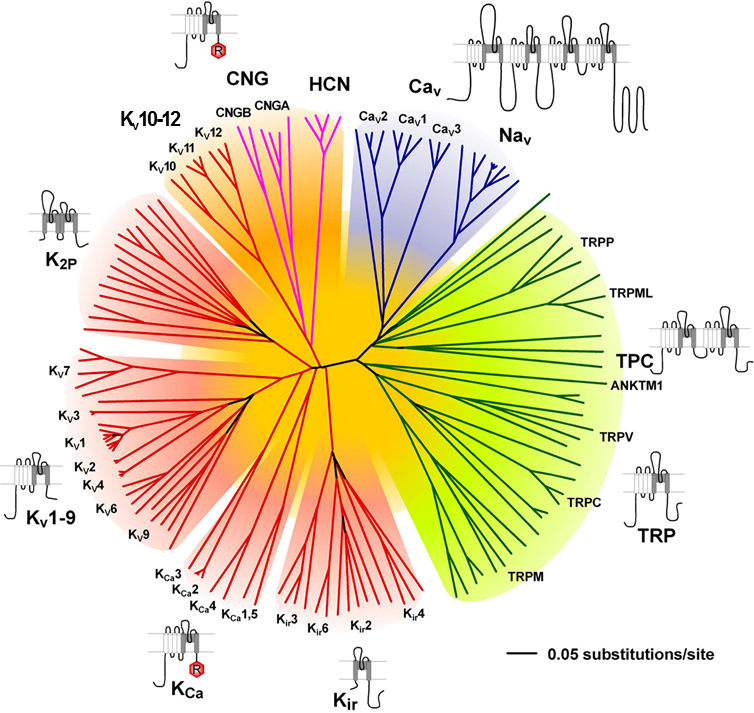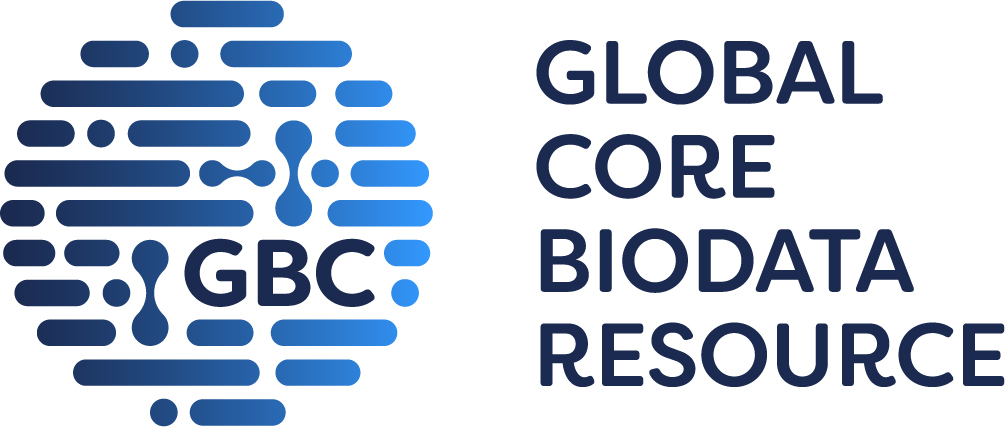
GtoPdb is requesting financial support from commercial users. Please see our sustainability page for more information.
- Home
- Targets
- Ion channels
- Voltage-gated ion channels
- Potassium channels
Overview
Show »« Hide
More detailed introduction 
Activation of potassium channels regulates excitability and can control the shape of the action potential waveform. They are present in all cells within the body and can influence processes as diverse as cognition, muscle contraction and hormone secretion. Potassium channels are subdivided into families, based on their structural and functional properties. The largest family consists of potassium channels that activated by membrane depolarization, with other families consisting of channels that are either activated by a rise of intracellular calcium ions or are constitutively active. A standardised nomenclature for potassium channels has been proposed by the NC-IUPHAR Subcommittees on potassium channels [1-4], which has placed cloned channels into groups based on gene family and structure of channels that exhibit 6, 4 or 2 transmembrane domains (TM).
Further reading
* Key recommended reading is highlighted with an asterisk
* Aguilar-Bryan L, Clement JP, Gonzalez G, Kunjilwar K, Babenko A, Bryan J. (1998) Toward understanding the assembly and structure of KATP channels. Physiol Rev, 78 (1): 227-45. [PMID:9457174]
Ahern CA, Kobertz WR. (2009) Chemical tools for K(+) channel biology. Biochemistry, 48 (3): 517-26. [PMID:19113860]
Ashcroft FM, Gribble FM. (1998) Correlating structure and function in ATP-sensitive K+ channels. Trends Neurosci, 21 (7): 288-94. [PMID:9683320]
Barrese V, Stott JB, Greenwood IA. (2018) KCNQ-Encoded Potassium Channels as Therapeutic Targets. Annu Rev Pharmacol Toxicol, 58: 625-648. [PMID:28992433]
Bauer CK, Schwarz JR. (2001) Physiology of EAG K+ channels. J Membr Biol, 182 (1): 1-15. [PMID:11426295]
Bayliss DA, Barrett PQ. (2008) Emerging roles for two-pore-domain potassium channels and their potential therapeutic impact. Trends Pharmacol Sci, 29 (11): 566-75. [PMID:18823665]
Bean BP. (2007) The action potential in mammalian central neurons. Nat Rev Neurosci, 8 (6): 451-65. [PMID:17514198]
Bezanilla F. (2000) The voltage sensor in voltage-dependent ion channels. Physiol Rev, 80 (2): 555-92. [PMID:10747201]
* Borsotto M, Veyssiere J, Moha Ou Maati H, Devader C, Mazella J, Heurteaux C. (2015) Targeting two-pore domain K(+) channels TREK-1 and TASK-3 for the treatment of depression: a new therapeutic concept. Br J Pharmacol, 172 (3): 771-84. [PMID:25263033]
* Chang PC, Chen PS. (2015) SK channels and ventricular arrhythmias in heart failure. Trends Cardiovasc Med, 25 (6): 508-14. [PMID:25743622]
Dalby-Brown W, Hansen HH, Korsgaard MP, Mirza N, Olesen SP. (2006) K(v)7 channels: function, pharmacology and channel modulators. Curr Top Med Chem, 6 (10): 999-1023. [PMID:16787276]
* Decher N, Kiper AK, Rinné S. (2017) Stretch-activated potassium currents in the heart: Focus on TREK-1 and arrhythmias. Prog Biophys Mol Biol, 130 (Pt B): 223-232. [PMID:28526352]
Enyedi P, Czirják G. (2010) Molecular background of leak K+ currents: two-pore domain potassium channels. Physiol Rev, 90 (2): 559-605. [PMID:20393194]
* Feliciangeli S, Chatelain FC, Bichet D, Lesage F. (2015) The family of K2P channels: salient structural and functional properties. J Physiol (Lond.), 593 (12): 2587-603. [PMID:25530075]
* Foster MN, Coetzee WA. (2016) KATP Channels in the Cardiovascular System. Physiol Rev, 96 (1): 177-252. [PMID:26660852]
* Gada K, Plant LD. (2019) Two-pore domain potassium channels: emerging targets for novel analgesic drugs: IUPHAR Review 26. Br J Pharmacol, 176 (2): 256-266. [PMID:30325008]
* Goldstein SA, Bayliss DA, Kim D, Lesage F, Plant LD, Rajan S. (2005) International Union of Pharmacology. LV. Nomenclature and molecular relationships of two-P potassium channels. Pharmacol Rev, 57 (4): 527-40. [PMID:16382106]
Goldstein SA, Bockenhauer D, O'Kelly I, Zilberberg N. (2001) Potassium leak channels and the KCNK family of two-P-domain subunits. Nat Rev Neurosci, 2 (3): 175-84. [PMID:11256078]
* Greene DL, Hoshi N. (2017) Modulation of Kv7 channels and excitability in the brain. Cell Mol Life Sci, 74 (3): 495-508. [PMID:27645822]
* Gutman GA, Chandy KG, Adelman JP, Aiyar J, Bayliss DA, Clapham DE, Covarriubias M, Desir GV, Furuichi K, Ganetzky B et al.. (2003) International Union of Pharmacology. XLI. Compendium of voltage-gated ion channels: potassium channels. Pharmacol Rev, 55 (4): 583-6. [PMID:14657415]
Hancox JC, McPate MJ, El Harchi A, Zhang YH. (2008) The hERG potassium channel and hERG screening for drug-induced torsades de pointes. Pharmacol Ther, 119 (2): 118-32. [PMID:18616963]
Hansen JB. (2006) Towards selective Kir6.2/SUR1 potassium channel openers, medicinal chemistry and therapeutic perspectives. Curr Med Chem, 13 (4): 361-76. [PMID:16475928]
Honoré E. (2007) The neuronal background K2P channels: focus on TREK1. Nat Rev Neurosci, 8 (4): 251-61. [PMID:17375039]
Jenkinson DH. (2006) Potassium channels--multiplicity and challenges. Br J Pharmacol, 147 Suppl 1: S63-71. [PMID:16402122]
Judge SI, Bever CT. (2006) Potassium channel blockers in multiple sclerosis: neuronal Kv channels and effects of symptomatic treatment. Pharmacol Ther, 111 (1): 224-59. [PMID:16472864]
* Kaczmarek LK, Aldrich RW, Chandy KG, Grissmer S, Wei AD, Wulff H. (2017) International Union of Basic and Clinical Pharmacology. C. Nomenclature and Properties of Calcium-Activated and Sodium-Activated Potassium Channels. Pharmacol Rev, 69 (1): 1-11. [PMID:28267675]
Kaczorowski GJ, Garcia ML. (1999) Pharmacology of voltage-gated and calcium-activated potassium channels. Curr Opin Chem Biol, 3 (4): 448-58. [PMID:10419851]
Kannankeril P, Roden DM, Darbar D. (2010) Drug-induced long QT syndrome. Pharmacol Rev, 62 (4): 760-81. [PMID:21079043]
Kobayashi T, Ikeda K. (2006) G protein-activated inwardly rectifying potassium channels as potential therapeutic targets. Curr Pharm Des, 12 (34): 4513-23. [PMID:17168757]
* Kubo Y, Adelman JP, Clapham DE, Jan LY, Karschin A, Kurachi Y, Lazdunski M, Nichols CG, Seino S, Vandenberg CA. (2005) International Union of Pharmacology. LIV. Nomenclature and molecular relationships of inwardly rectifying potassium channels. Pharmacol Rev, 57 (4): 509-26. [PMID:16382105]
* Latorre R, Castillo K, Carrasquel-Ursulaez W, Sepulveda RV, Gonzalez-Nilo F, Gonzalez C, Alvarez O. (2017) Molecular Determinants of BK Channel Functional Diversity and Functioning. Physiol Rev, 97 (1): 39-87. [PMID:27807200]
Lawson K, McKay NG. (2006) Modulation of potassium channels as a therapeutic approach. Curr Pharm Des, 12 (4): 459-70. [PMID:16472139]
Lesage F. (2003) Pharmacology of neuronal background potassium channels. Neuropharmacology, 44 (1): 1-7. [PMID:12559116]
Lewis RJ, Garcia ML. (2003) Therapeutic potential of venom peptides. Nat Rev Drug Discov, 2 (10): 790-802. [PMID:14526382]
Lüscher C, Slesinger PA. (2010) Emerging roles for G protein-gated inwardly rectifying potassium (GIRK) channels in health and disease. Nat Rev Neurosci, 11 (5): 301-15. [PMID:20389305]
Mannhold R. (2006) Structure-activity relationships of K(ATP) channel openers. Curr Top Med Chem, 6 (10): 1031-47. [PMID:16787278]
Mathie A, Veale EL. (2007) Therapeutic potential of neuronal two-pore domain potassium-channel modulators. Curr Opin Investig Drugs, 8 (7): 555-62. [PMID:17659475]
Miller C. (2003) A charged view of voltage-gated ion channels. Nat Struct Biol, 10 (6): 422-4. [PMID:12768203]
Nardi A, Olesen SP. (2008) BK channel modulators: a comprehensive overview. Curr Med Chem, 15 (11): 1126-46. [PMID:18473808]
Nichols CG, Lopatin AN. (1997) Inward rectifier potassium channels. Annu Rev Physiol, 59: 171-91. [PMID:9074760]
* Niemeyer MI, Cid LP, González W, Sepúlveda FV. (2016) Gating, Regulation, and Structure in K2P K+ Channels: In Varietate Concordia?. Mol Pharmacol, 90 (3): 309-17. [PMID:27268784]
Pongs O, Schwarz JR. (2010) Ancillary subunits associated with voltage-dependent K+ channels. Physiol Rev, 90 (2): 755-96. [PMID:20393197]
* Poveda JA, Marcela Giudici A, Lourdes Renart M, Morales A, González-Ros JM. (2017) Towards understanding the molecular basis of ion channel modulation by lipids: Mechanistic models and current paradigms. Biochim Biophys Acta, 1859 (9 Pt B): 1507-1516. [PMID:28408206]
Reimann F, Ashcroft FM. (1999) Inwardly rectifying potassium channels. Curr Opin Cell Biol, 11 (4): 503-8. [PMID:10449331]
* Rifkin RA, Moss SJ, Slesinger PA. (2017) G Protein-Gated Potassium Channels: A Link to Drug Addiction. Trends Pharmacol Sci, 38 (4): 378-392. [PMID:28188005]
Robbins J. (2001) KCNQ potassium channels: physiology, pathophysiology, and pharmacology. Pharmacol Ther, 90 (1): 1-19. [PMID:11448722]
Salkoff L, Butler A, Ferreira G, Santi C, Wei A. (2006) High-conductance potassium channels of the SLO family. Nat Rev Neurosci, 7 (12): 921-31. [PMID:17115074]
Sanguinetti MC. (2000) Maximal function of minimal K+ channel subunits. Trends Pharmacol Sci, 21 (6): 199-201. [PMID:10838601]
Seino S, Miki T. (2003) Physiological and pathophysiological roles of ATP-sensitive K+ channels. Prog Biophys Mol Biol, 81 (2): 133-76. [PMID:12565699]
Stanfield PR, Nakajima S, Nakajima Y. (2002) Constitutively active and G-protein coupled inward rectifier K+ channels: Kir2.0 and Kir3.0. Rev Physiol Biochem Pharmacol, 145: 47-179. [PMID:12224528]
Stocker M. (2004) Ca(2+)-activated K+ channels: molecular determinants and function of the SK family. Nat Rev Neurosci, 5 (10): 758-70. [PMID:15378036]
Takeda M, Tsuboi Y, Kitagawa J, Nakagawa K, Iwata K, Matsumoto S. (2011) Potassium channels as a potential therapeutic target for trigeminal neuropathic and inflammatory pain. Mol Pain, 7: 5. [PMID:21219657]
* Taylor KC, Sanders CR. (2017) Regulation of KCNQ/Kv7 family voltage-gated K+ channels by lipids. Biochim Biophys Acta, 1859 (4): 586-597. [PMID:27818172]
Trimmer JS, Rhodes KJ. (2004) Localization of voltage-gated ion channels in mammalian brain. Annu Rev Physiol, 66: 477-519. [PMID:14977411]
* Vivier D, Bennis K, Lesage F, Ducki S. (2016) Perspectives on the Two-Pore Domain Potassium Channel TREK-1 (TWIK-Related K(+) Channel 1). A Novel Therapeutic Target?. J Med Chem, 59 (11): 5149-57. [PMID:26588045]
Wang H, Tang Y, Wang L, Long CL, Zhang YL. (2007) ATP-sensitive potassium channel openers and 2,3-dimethyl-2-butylamine derivatives. Curr Med Chem, 14 (2): 133-55. [PMID:17266574]
Weatherall KL, Goodchild SJ, Jane DE, Marrion NV. (2010) Small conductance calcium-activated potassium channels: from structure to function. Prog Neurobiol, 91 (3): 242-55. [PMID:20359520]
* Wei AD, Gutman GA, Aldrich R, Chandy KG, Grissmer S, Wulff H. (2005) International Union of Pharmacology. LII. Nomenclature and molecular relationships of calcium-activated potassium channels. Pharmacol Rev, 57 (4): 463-72. [PMID:16382103]
Wickenden AD, McNaughton-Smith G. (2009) Kv7 channels as targets for the treatment of pain. Curr Pharm Des, 15 (15): 1773-98. [PMID:19442190]
Witchel HJ. (2007) The hERG potassium channel as a therapeutic target. Expert Opin Ther Targets, 11 (3): 321-36. [PMID:17298291]
Wulff H, Castle NA, Pardo LA. (2009) Voltage-gated potassium channels as therapeutic targets. Nat Rev Drug Discov, 8 (12): 982-1001. [PMID:19949402]
* Yang KC, Nerbonne JM. (2016) Mechanisms contributing to myocardial potassium channel diversity, regulation and remodeling. Trends Cardiovasc Med, 26 (3): 209-18. [PMID:26391345]
Yellen G. (2002) The voltage-gated potassium channels and their relatives. Nature, 419 (6902): 35-42. [PMID:12214225]
Yu FH, Catterall WA. (2004) The VGL-chanome: a protein superfamily specialized for electrical signaling and ionic homeostasis. Sci STKE, 2004 (253): re15. [PMID:15467096]
References
1. Goldstein SA, Bayliss DA, Kim D, Lesage F, Plant LD, Rajan S. (2005) International Union of Pharmacology. LV. Nomenclature and molecular relationships of two-P potassium channels. Pharmacol Rev, 57 (4): 527-40. [PMID:16382106]
2. Gutman GA, Chandy KG, Grissmer S, Lazdunski M, McKinnon D, Pardo LA, Robertson GA, Rudy B, Sanguinetti MC, Stühmer W et al.. (2005) International Union of Pharmacology. LIII. Nomenclature and molecular relationships of voltage-gated potassium channels. Pharmacol Rev, 57 (4): 473-508. [PMID:16382104]
3. Kubo Y, Adelman JP, Clapham DE, Jan LY, Karschin A, Kurachi Y, Lazdunski M, Nichols CG, Seino S, Vandenberg CA. (2005) International Union of Pharmacology. LIV. Nomenclature and molecular relationships of inwardly rectifying potassium channels. Pharmacol Rev, 57 (4): 509-26. [PMID:16382105]
4. Wei AD, Gutman GA, Aldrich R, Chandy KG, Grissmer S, Wulff H. (2005) International Union of Pharmacology. LII. Nomenclature and molecular relationships of calcium-activated potassium channels. Pharmacol Rev, 57 (4): 463-72. [PMID:16382103]
How to cite this family page
Database page citation:
Potassium channels. Accessed on 20/12/2025. IUPHAR/BPS Guide to PHARMACOLOGY, http://www.guidetopharmacology.org/GRAC/FamilyDisplayForward?familyId=133.
Concise Guide to PHARMACOLOGY citation:
Alexander SPH, Mathie A, Peters JA, Veale EL, Striessnig J, Kelly E, Armstrong JF, Faccenda E, Harding SD, Pawson AJ, Sharman JL, Southan C, Davies JA; CGTP Collaborators. (2019) The Concise Guide to PHARMACOLOGY 2019/20: Ion channels. Br J Pharmacol. 176 Issue S1: S142-228.
 This work is licensed under a Creative Commons Attribution-ShareAlike 4.0 International License
This work is licensed under a Creative Commons Attribution-ShareAlike 4.0 International License







